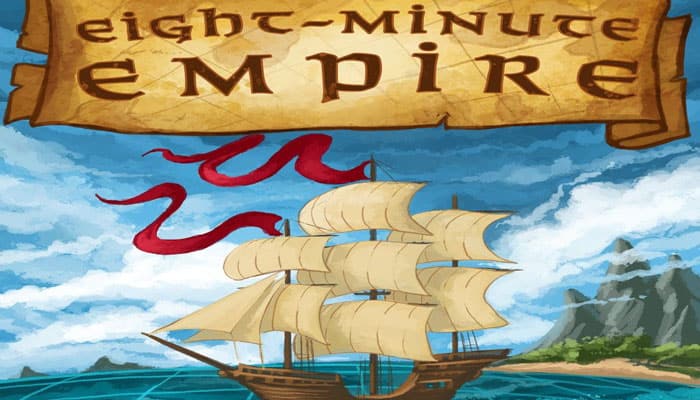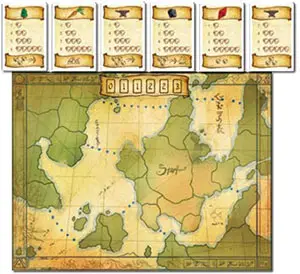
Components

- 1 Double Sided Game Board
- Rulebook
- 42 Cards
- 5 Sets of player pieces (3 discs and 14 cubes in red, blue, white, yellow and green)
- 44 Coin Tokens
- 10 Goods Tokens
Setup
-
Place the board on the table.
-
If playing with 2, 3, or 4 players, go through the cards and remove the five cards with the little number "5" in the top right corner, just below the scroll on which the good is displayed.
Shuffle the cards and place them in a deck face down next to the board. Draw six cards and place them face up in a row along the top of the board.
-
Each player takes a set of one color of cubes (14 armies) and discs (3 cities). Each player places 3 armies on the starting region on the board. If playing with 2 players, each player takes turns placing one army at a time of a third, non-player color in any region on the board until ten armies have been placed.
-
Place the coin tokens in a pile next to the board. This is the supply. Each player takes 8 coins if playing with five players, 9 coins if playing with four players, 11 coins with three, and 14 coins with two.
You are now ready to play

Game Play
1. Players bid to see who will choose the first player. Each player picks up his coins and secretly chooses a number to bid by placing them in a closed fist and holding the fist out over the game board.
When all players are ready, all players reveal the amount they have chosen to bid at the same time. The player who bids the most coins wins the bid and puts the coins he bid in the supply. Other players do not pay coins if they lost the bid.
If the bids are tied for most, the youngest player wins the bid and pays his coins. If all bids are zero, the youngest player wins the bid. There is only one bid per game. The winner of the bid chooses who will be first player.
2. Starting with the first player and going in clockwise order, players take turns taking one of the face up cards. When a player takes a card, he places it face up in front of him.
He must pay the appropriate coin cost for the card depending on where it is in the row (this cost is listed at the top of the board). From left to right, these are the coin costs of the cards: 0, 1, 1, 2, 2, and 3. For example, if a player selected the third card from the left, he would pay one coin.

The card gives a good and an action. The player takes the action immediately. Actions allow players to build their empires and take control of the board. The following are possible actions:
Place new armies on the board

The number of armies shown indicates how many the player may place.
You may place them only on the starting region or on a region where you have a city. Armies need not be placed all in the same region.
Move Armies

The number of armies shown indicates the amount of movement the card gives you.
For example, this action shows 3 armies, so you could move one army up to 3 times, or 3 armies one time each, or 1 army two times and another army one time.
This action is only for land movement and does not allow you to cross the dotted lines over oceans.
Move over Land and/or Water

Same as "Move Armies" described above, but you may also move between two regions connected by a dotted line (over water) as if they were adjacent.
Build a City

Place a city anywhere on the board where you have an army. Regions can contain more than one city from any number of players.
Destroy Army

You may remove an army from the board belonging to any player from any location.
"And/or" Actions

If there are two different actions on the card with an "or" between them, you may choose which action to perform. If there are two different actions on the card with an "and" between them, you may perform both actions.
Note: If a player so chooses, he may take the card and ignore the action.
After a player takes his card and action, slide the remaining cards to the left to fill in the empty card space. Draw a new card and place it in the right-most space. Play then passes to the left.

End of the Game
The game ends when each player owns a certain number of cards depending on the number of players.
- 2 Players 13 Cards
- 3 Players 10 Cards
- 4 Players 8 Cards
- 5 Players 7 Cards
 Players now count up victory points in their heads.
Players now count up victory points in their heads.
Regions: A player gains one victory point for each region on the map he controls. A player controls a region if he has more armies there than any other player (cities count as armies when determining control). If players have the same number of armies in a region, no one controls it.
Continents: A player gains one victory point for each continent he controls. A player controls a continent if he controls more regions in the continent than anyone else. If players are tied for controlled regions, no one controls the continent.

Goods: A player gains victory points for his sets of goods. Players can now decide where to place their "Wild" cards. "Wild" goods cards can be added to any goods cards a player already owns for one extra of that good per "Wild" card.
The amount of victory points each good is worth depends on how many cards of that good he has and is listed in the middle of the card in four amounts. For example, Crystals are worth 1 point for one card, 2 for two cards, 3 for three cards, and 5 for four cards.
The player who has the most victory points from regions, continents, and goods has the most powerful empire and is the winner! If players are tied, the player with the most coins wins. If still tied, the player with the most armies on the board wins. If still tied, the player with the most controlled regions wins.
Variants
Full Game: For a longer experience, play three games. The player with the highest sum of victory points from all three games is the winner.
Goods Tokens: During game setup, randomly place one of the goods tokens on each region on the board with a triangle. The player who controls a region with a good token in it has one more of the depicted good.
Alternate Bidding Tie Breaker: Instead of the youngest player winning the first-player bid when tied, roll a die to see who wins.
Continue Reading


